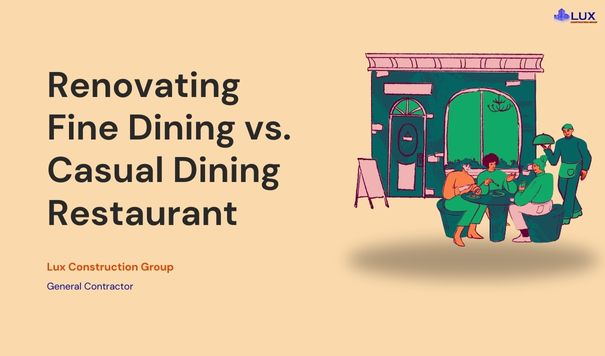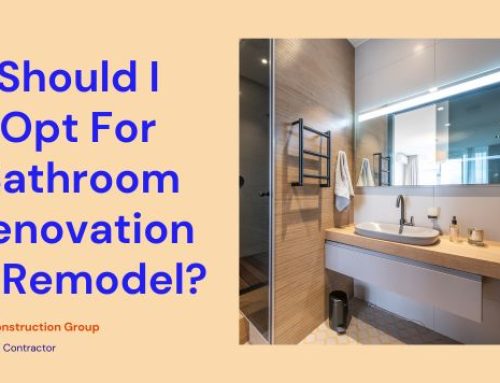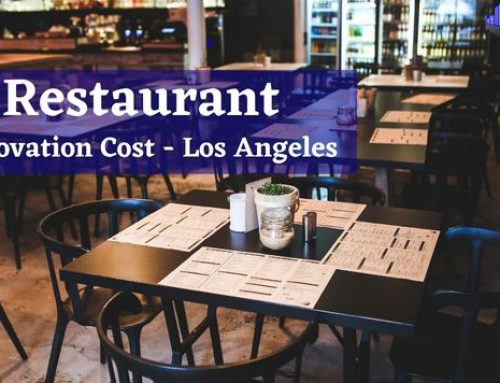Restaurant renovations, where the design isn’t just about aesthetics—it’s a pivotal factor that defines your brand and shapes your customers’ experiences.
Do you prefer luxurious fine dining or the laid-back atmosphere of casual dining?
You are not alone! Many restaurateurs grapple with this decision, unaware of how deeply it influences everything from the layout to the lighting.
Let’s explore just what makes a restaurant fine dining — or casual. We will also go through how lighting, layout, furniture, and even the color scheme can be tailored to suit the concept you’re aiming for. Once you understand the difference, you’ll be ready to make a reservation at a restaurant that’s perfect for you. So, let’s take a look!
What is Fine Dining?
When it comes to restaurant concepts, fine dining stands in a league of its own, offering an unparalleled culinary experience that goes beyond just food. But what exactly is fine dining, and how does it fit into the broader landscape of restaurant concepts? Let’s dig in!
Fine dining is the epitome of culinary excellence, combining gourmet cuisine, exquisite ambiance, and impeccable service. It’s not just a meal; it’s an event. This concept is often associated with luxurious interiors, high-quality ingredients, and a meticulously curated menu, often crafted by renowned chefs.
Key Features of Fine Dining
- Gourmet Cuisine: Expect dishes that are not only delicious but also artfully presented.
- Ambiance: Fine dining establishments invest heavily in creating a mood—think elegant table settings, mood lighting, and often, live music.
- Service: The staff is usually highly trained, offering personalized service that aims to exceed guest expectations.
- Price Point: Fine dining comes at a premium, reflecting the quality of food and the level of service provided.
If you’re considering renovating your restaurant, pivoting to a fine dining concept can be a game-changer. It allows you to target a specific clientele willing to pay a premium for a high-quality experience. It’s also an excellent opportunity for culinary creativity, letting chefs experiment with unique ingredients and cooking techniques.
Switching to a fine dining concept isn’t just about updating the menu; it requires a complete overhaul of the restaurant’s design and decor. Attention to detail is crucial—from the type of silverware and dishes you use to the lighting and acoustics.
What is Casual Dining?
Are you considering a casual dining concept for your restaurant? If so, you’re tapping into a market that values comfort, affordability, and a laid-back atmosphere. But what exactly does casual dining entail, and how does it differ from other restaurant concepts like fine dining? Let’s explore!
Key Features of Casual Dining
- Varied Menu: One of the hallmarks of casual dining is a diverse menu that caters to a wide range of tastes. From burgers and fries to salads and pasta, the options are plentiful.
- Ambiance: The setting is relaxed and inviting, often featuring themed decor that adds to the overall dining experience. Think of cozy booths, open spaces, and a family-friendly environment.
- Service: While the service is efficient and friendly, it’s less formal compared to fine dining. You might find servers in casual uniforms rather than formal attire.
- Price Point: Casual dining is generally more budget-friendly, making it accessible to a broader audience.
Opting for a casual dining concept can be a strategic move, especially if you’re targeting families, groups of friends, or individuals looking for a relaxed dining experience. It’s also a great choice if you want to offer a broad menu that appeals to various tastes and dietary preferences.
If you’re transitioning from another concept to casual dining, keep in mind that the renovation will involve more than just a menu change. The decor, layout, and even the kitchen setup may need to be revamped to align with the casual dining atmosphere.
Does Restaurant Renovation Require Any Planning?
Yes! When renovating a restaurant, it’s not only about applying a fresh coat of paint or replacing the upholstery. It’s a complex process that requires meticulous planning and execution. Whether you’re transitioning to a fine dining establishment or aiming for a more casual dining vibe, planning is the cornerstone of a successful renovation.
Here’s what you need to consider:
Budget Considerations
The first step in any renovation project is setting a budget. This is especially crucial for restaurant owners, as the costs can quickly spiral out of control if not carefully managed.
For a fine dining concept, you may need to allocate funds for luxurious elements like high-end furniture, custom lighting, and possibly even art installations. On the other hand, casual dining might require a more modest budget but still needs careful planning to ensure quality and durability.
Timeline Planning
Time is money, especially in the restaurant business. Every day your restaurant is closed for renovation is a day of lost revenue. Therefore, it’s essential to have a realistic timeline for your project.
This includes time for design, construction, and any unforeseen delays that might occur. A well-planned timeline ensures that you can reopen your doors as quickly as possible, whether you’re unveiling a fine dining masterpiece or a cozy casual dining space.
Regulatory Requirements
Before you start tearing down walls or installing new fixtures, you need to be aware of the local building codes and regulations.
This includes health and safety standards, accessibility requirements, and even zoning laws that might affect your restaurant’s operation. Failure to comply can result in hefty fines or even legal action, derailing your renovation plans and affecting your business reputation.
What Is the Difference Between Fine Dining and Casual Dining?
When it comes to the restaurant industry, the concept you choose can significantly impact your business. Fine dining and casual dining are two distinct models, each with its own set of characteristics, customer expectations, and operational requirements.
So, what sets them apart? Let’s delve into the key differences.
Atmosphere and Ambiance
- Fine Dining: The atmosphere in a fine dining establishment is often luxurious and elegant, designed to create a sense of exclusivity. Attention to detail is paramount, from the choice of tableware to the lighting and decor.
- Casual Dining: The atmosphere is relaxed and inviting, often with a thematic or regional focus. The ambiance is comfortable, making guests feel at ease.
Menu and Cuisine
- Fine Dining: The menu is usually curated by a renowned chef and features gourmet dishes made from high-quality ingredients. The focus is on culinary artistry and innovation.
- Casual Dining: The menu is diverse, offering a range of options to cater to a broader audience. While the food is delicious, it’s generally less experimental than fine dining.
Service Standards
- Fine Dining: The service is impeccable, and often personalized to meet the unique needs of each guest. Staff are highly trained and knowledgeable about the menu, wine pairings, and more.
- Casual Dining: The service is friendly and efficient but less formal. Staff are trained to provide good service but may not have the specialized knowledge found in fine dining establishments.
Price Point
- Fine Dining: The cost is premium, reflecting the high-quality ingredients, exceptional service, and overall experience.
- Casual Dining: The price point is more affordable, making it accessible to a wider range of customers.
Target Audience
- Fine Dining: Generally targets an upscale audience looking for a luxurious dining experience.
- Casual Dining: Caters to a broader demographic, including families, groups of friends, and couples looking for a relaxed meal.
Dress Code
- Fine Dining: Often has a strict dress code requiring formal attire.
- Casual Dining: The dress code is usually relaxed, allowing for casual wear.
Renovation Considerations
- Fine Dining: Renovating a fine dining concept often involves significant changes, including luxurious furnishings, high-end kitchen equipment, and specialized staff training.
- Casual Dining: Renovations may be less extensive, focusing on creating a comfortable and inviting atmosphere.
Understanding these key differences can make an informed decision when considering a renovation to transition between fine dining and casual dining concepts. Each has its own set of challenges and rewards, and the choice ultimately depends on your business goals, location, and target audience.
How To Design a Fine Dining in Your Restaurant
Creating a fine dining experience in your restaurant is more than just offering gourmet food; it’s about crafting an unforgettable experience that starts the moment your guests walk through the door.
Let’s explore the key elements you need to consider when designing a fine dining atmosphere.
Ambiance and Atmosphere
- What to Consider: The ambiance sets the tone for the entire dining experience. It’s not just about looking good; it’s about creating a mood that complements the culinary journey you’re offering.
- How to Achieve It: Use elements like soft background music, elegant artwork, and a cohesive color scheme to create a luxurious yet intimate atmosphere. Attention to detail is crucial; even the smallest elements, like the texture of the napkins or the design of the menu, contribute to the overall ambiance.
Interior Design
- What to Consider: The interior design should reflect the level of sophistication and luxury that your fine dining concept promises.
- How to Achieve It: Invest in high-quality materials like marble countertops, hardwood floors, or custom wall treatments. The layout should facilitate smooth movement for both staff and guests. Consider hiring a professional interior designer who specializes in fine dining spaces. The color scheme should be cohesive and subdued, allowing the food and service to take center stage.
Lighting
- What to Consider: Lighting plays a pivotal role in setting the mood. It should be neither too bright nor too dim.
- How to Achieve It: Use a combination of natural and artificial lighting. Chandeliers or pendant lights can add a touch of elegance, while table lamps or candles can create intimate settings. You can also go for soft, dimmable lights that can be adjusted to create the perfect atmosphere. Dimmable lights are a good option for adjusting the brightness as needed.
Furniture and Fixtures
- What to Consider: The furniture should not only be comfortable but also align with the overall aesthetic of the restaurant.
- How to Achieve It: High-quality chairs and tables made from premium materials not only look good but also enhance the overall dining experience. Don’t forget the table settings—fine china, crystal glassware, and polished silverware are a must.
Custom-made pieces can add a unique touch. The fixtures, like door handles and bathroom fittings, should also be in sync with the restaurant’s luxurious vibe.
Kitchen and Back-of-House Considerations
- What to Consider: A fine dining experience is not just about what’s visible to the guests. The kitchen and back-of-house areas are equally important for ensuring seamless service.
- How to Achieve It: Invest in top-of-the-line kitchen appliances and ensure that the kitchen layout is efficient for the staff. The kitchen should be equipped to handle the demands of gourmet cooking. This means investing in high-end kitchen appliances and ensuring that the layout is efficient for the chefs to work in. The back-of-house should also be designed to facilitate excellent service, with a well-planned flow from the kitchen to the dining area. Storage areas should be well-organized, and there should be a dedicated space for dishwashing that doesn’t interfere with food preparation.
Paying attention to these key areas can create a fine dining experience that stands out for its quality and attention to detail. Whether it’s the lighting, the furniture, or the back-of-house setup, each element should work in harmony to deliver an experience that meets, if not exceeds, your guests’ expectations.
How to Design a Casual Dining in Your Restaurant
Creating a casual dining atmosphere is all about balancing comfort with efficiency. Unlike fine dining, the focus here is on a relaxed environment where guests can enjoy good food without the formalities. Let’s dive into the key components that make up a successful casual dining setup.
Set a Welcoming Tone
- What to Consider: The first impression is crucial. You want to create an environment that immediately feels welcoming and relaxed.
- How to Achieve It: Use warm colors, inviting signage, and friendly staff to greet guests as they enter. The goal is to make them feel at home as soon as they walk through the door.
Interior Design
- What to Consider: The interior should be comfortable and inviting, often reflecting a particular theme or style that resonates with your target audience.
- How to Achieve It: Consider using natural materials like wood or stone for a rustic feel, or go for a modern look with sleek lines and vibrant colors. Wall art and decor should complement the chosen theme.
Seating Arrangements
- What to Consider: The seating should accommodate various group sizes and offer flexibility for different occasions, from family dinners to date nights.
- How to Achieve It: Use a mix of booth seating, tables, and bar stools to offer variety. Make sure there’s enough space between tables for comfortable movement and privacy.
Menu Presentation and Ordering Systems
- What to Consider: The menu should be easy to read and understand, and the ordering process should be straightforward.
- How to Achieve It: Use clear fonts and simple language for the menu. Consider incorporating digital ordering systems or tablets for a more interactive experience. Specials and promotions should be prominently displayed.
Kitchen and Efficiency
- What to Consider: In casual dining, efficiency is key. The kitchen should be designed for quick service without compromising on food quality.
- How to Achieve It: Plan an efficient kitchen layout that minimizes staff movement and speeds up cooking times. Invest in reliable kitchen appliances and ensure that prep stations are well-organized.
Incorporate Entertainment
- What to Consider: Entertainment can add an extra layer of enjoyment for your guests, making their dining experience more memorable.
- How to Achieve It: Depending on your target audience, consider adding features like a jukebox, live music nights, or even board games. Make sure it aligns with the overall vibe of your restaurant.
Focusing on these essential elements can create a casual dining experience that appeals to a broad range of customers. From the welcoming tone to the efficient kitchen setup, each aspect plays a role in defining the overall experience and ensuring that guests leave satisfied.
Conclusion!
Whether you’re leaning towards the elegance of fine dining or the laid-back atmosphere of casual dining, the design and layout of your restaurant play a pivotal role in defining the customer experience. From the moment guests walk in, every detail, from the ambiance to the kitchen efficiency, contributes to their overall impression of your establishment. Carefully considering each element can create a dining environment that not only meets but exceeds customer expectations, setting you apart in a competitive market.
If you’re considering a renovation to transition between these dining concepts or simply to upgrade your current setup, professional help can make all the difference. That’s where LUX Construction Group comes in. Specializing in restaurant renovations, we bring your vision to life with unparalleled craftsmanship and attention to detail. Our team of experts works closely with you to understand your needs, offering tailored solutions that align with your brand and budget.
So why settle for ordinary when you can create an extraordinary dining experience? Contact LUX Construction Group today and take the first step towards transforming your restaurant.





